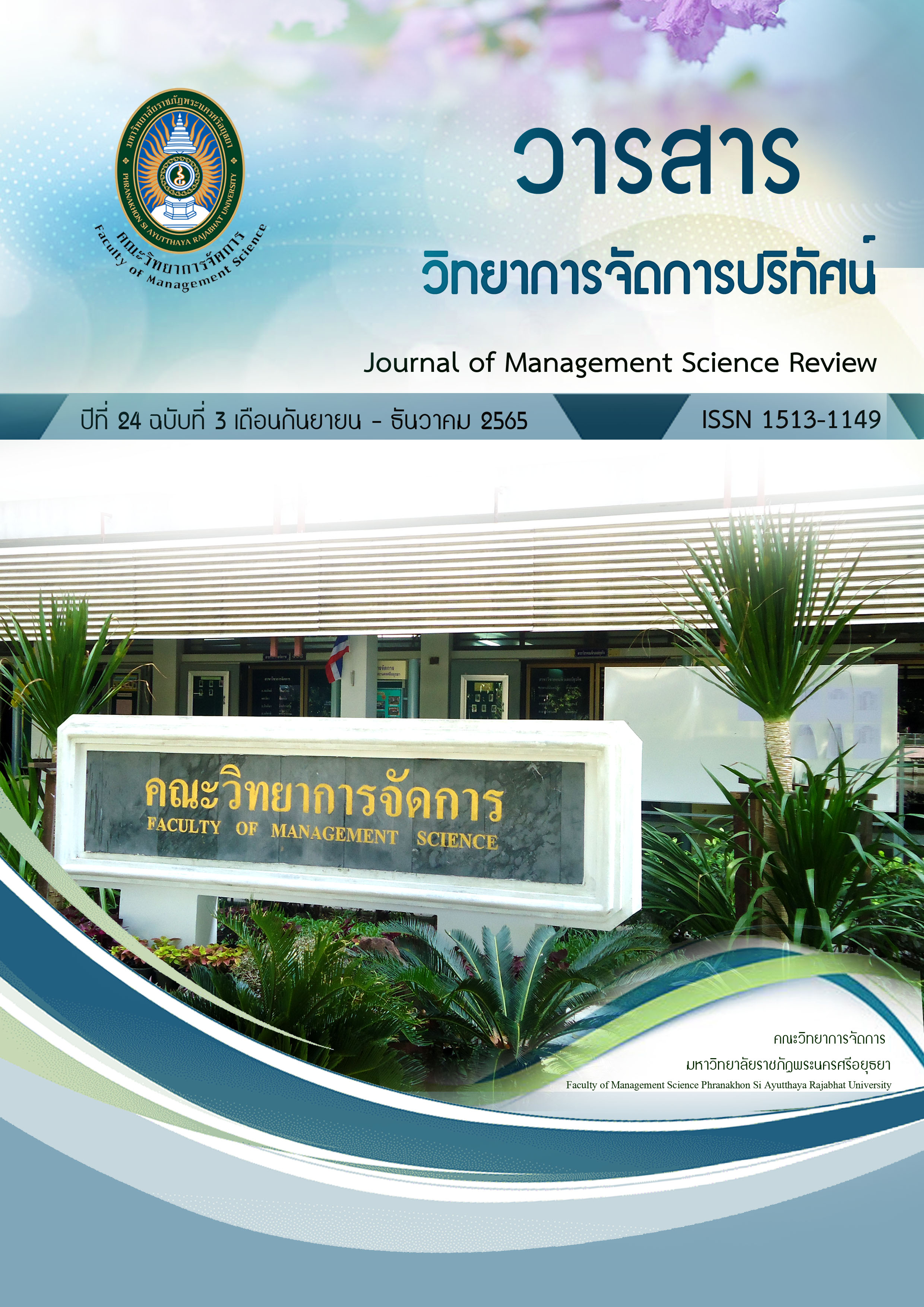กลยุทธ์การตลาดลัคชัวรี่แบรนด์ในยุคความปกติถัดไป Next Normal
คำสำคัญ:
กลยุทธ์การตลาด, แบรนด์ลัคชัวรี่, แบรนด์, ความปกติถัดไปบทคัดย่อ
ลัคชัวรี่แบรนด์ เป็นผลิตภัณฑ์คุณภาพสูง มีเอกลักษณ์เฉพาะตัวที่โดดเด่น และมีราคาแพง ถึงแม้ที่ผ่านมาจะมีอุปสรรคในช่วงสถานการณ์โรคระบาดโควิด 19 แต่ก็สามารถสร้างผลกำไร และฟื้นตัวได้อย่างรวดเร็วแม้แบรนด์จะมี การปรับราคาขึ้นก็ตาม เนื่องจากแบรนด์ทราบกลุ่มเป้าหมายทางการตลาดที่มีศักยภาพในการซื้อ และแบรนด์มี การปรับตัวการสร้างภาพลักษณ์ที่ดีต่อผู้บริโภค เสริมสร้างกลุ่มผู้บริโภคที่ต้องการหน้าตาทางสังคม ความน่าเชื่อถือ และต้องการผลิตภัณฑ์ที่มีคุณภาพดี บริการเป็นเลิศตอบสนองตามความคาดหวังของผู้บริโภค
บทความนี้ทำการทบทวนวรรณกรรม แนวคิด องค์ประกอบ ประเภทของผู้บริโภค ขั้นตอนการสร้างแบรนด์ และกลยุทธ์ลัคชัวรี่แบรนด์ ให้ประสบความสำเร็จ ผู้ประกอบการธุรกิจอื่น ๆ สามารถนำกลยุทธ์ทางการตลาดลัคชัวรี่มาประยุกต์ใช้ในการพัฒนาความสามารถของแบรนด์ตนเองให้แข็งแกร่งสอดคล้องกับบริบทพฤติกรรมความต้องการของผู้บริโภคในปัจจุบัน และอนาคตได้
เอกสารอ้างอิง
ธนาคารกสิกร. (2565). เสริมพลังธุรกิจปี65. ค้นเมื่อ 15 สิงหาคม 2565, จาก https://www.kasikornbank.com/th/personal/thewisdom/articles/Pages/Onward65_Business-Empowerment_2022.aspx
ธนาคารไทยพาณิชย์. (2564). ประมาณการเศรษฐกิจไทย ปี 2020 และ 2021. ค้นเมื่อ 15 สิงหาคม 2565, จาก https://www.scbeic.com/th/detail/product/7265
ธนาคารแห่งประเทศไทย. (2564). 80 ปี ที่ผ่านมาและก้าวที่เดินต่อไปข้างหน้าอย่างมั่นคง. BOT พระสยาม Magazine, (6), 1-64.
Aleem, A., Loureiro, S.M.C. & Bilro, R.G. (2022).
Luxury fashion consumption: a review, synthesis and research agenda. Spanish Journal of Marketing - ESIC, 2(2022), 1-21. from https://doi.org/10.1108/SJME-06-2021-0105
Amatulli, C., Guido, G., Mileti, A., Tomacelli, C., Prete, M. I. & Longo, A. E. (2016). Mix-and-Match” Fashion Trend and Luxury Brand Recognition: An Empirical Test Using Eye-tracking Fashion Theory. The Journal of Dress, Body & Culture, 20(3), 341-362.
Athwal, N., Istanbulluoglu, D. & McCormack, S.
(2018). The allure of luxury brands’ social media activities: a uses and gratifications perspective. Information Technology & People, from https://doi.org/10.1108/ITP-01-2018-0017.
Atwal, G. & Williams, A. (2017). Luxury Brand Marketing – The Experience Is Everything. Advances in Luxury Brand Management, 16(1), 338-346.
Berger, J. (2017). Are Luxury Brand Labels and Green” Labels Costly Signals of Social Status? An Extended Replication. PLOS ONE, 12(2), 1-17.
Bian, X., Haque, S. & Smith, A. (2014). Social power, product conspicuousness, and the demand for luxury brand counterfeit products. British Journal of Social Psychology, 54(1), 37–54.
Chang, Y., Ko, Y. J. & Leite, W. (2016). The effect of perceived brand leadership on luxury service WOM. Journal of Services Marketing, 30(6), 659-671.
De Kerviler, G. & Rodriguez, C. M. (2019).
Luxury brand experiences and relationship quality for Millennials: The role of self-expansion. Journal of Business Research, 102(C), 250-262.
Douglas, A. F. & Moore, C. (2009). The anatomy of the luxury fashion brand. Journal of Brand Management, 16(5-6), 347-363.
Jin, N. P., Seungwon, L. & Jun, J. H. (2015). The
role of brand credibility in predicting consumers' behavioural intentions in luxury restaurants. Anatolia, 26(3), 1-13.
Jin, Y. J., Park, S. C. & Yoo, J. W. (2017). Effects of corporate social responsibility on consumer credibility perception and attitude toward luxury brands. Social Behavior and Personality: an international journal, 45(5), 795-808.
Kauppinen-Räisänen, H., Gummerus, J., von Koskull, C. & Cristini, H. (2019). The new wave of luxury: The meaning and value of luxury to the contemporary consumer. Qualitative Market Research: An International Journal, 22(3), 229-249.
Ko, E., Phau, I. & Aiello, G. (2016). Luxury brand
strategies and customer experiences: Contributions to theory and practice. Journal of Business Research, 69(12), 5749-5752.
Miller, K. & Mills, M. (2012). Probing Brand Luxury: A Multiple Lens Approach. Journal of Brand Management, 20(1), 41–51.
Pine, B. J. & Gilmore, J. H. (1998). Welcome to the experience economy. Harvard Business Review, July-August (1998), 97–105.
Reuters News. (2022). Luxury group LVMH beats expectations despite China drag on sales. Retrieved August, 15 2022, from https://www.reuters.com/business/retail-consumer/lvmh-q2-sales-climb-19-offsetting-slower-china-2022-07-26/
Scussel, F. & Demo, G. (2019). The Relational
Aspects of Luxury Consumption in Brazil: The development of a Luxury Customer Relationship Perception Scale and the Analysis of Brand Personality Influence on Relationship Perception on Luxury Fashion Brands. Brazilian Business Review, 16(2), 174-190.
Seo, Y. & Oliver, M. B. (2015). Luxury branding: The industry, trends, and future conceptualizations. Asia Pacific Journal of Marketing and Logistics, 27(1), 82-98.Shang, J. J
(2022). Will the Covid-19 Reshape the Marketing of Luxury Brands?, Proceedings of the 2022 7th International Conference on Financial Innovation and Economic Development, from https:// doi. org/10.2991/aebmr.k.220307.078
Tynan, C., McKechnie, S. & Chhuon, C. (2010). Co-creating value for luxury brands. Journal of Business Research, 63(11), 1156-1163.
Wiedman, K. P., Hennigs, N. & Siebels, A. (2007). Measuring consumers’ luxury value perception: a Cross- Cultural Framework. Academy of Marketing Review, 7(1), 1-18.





